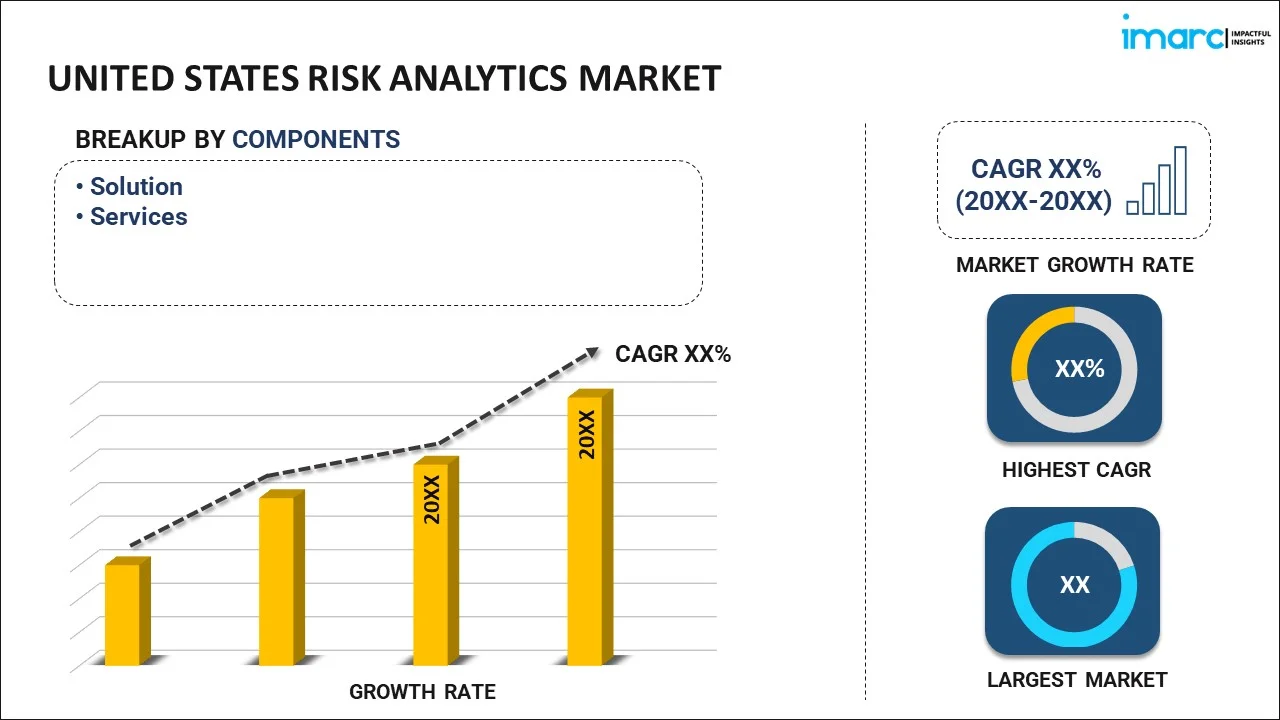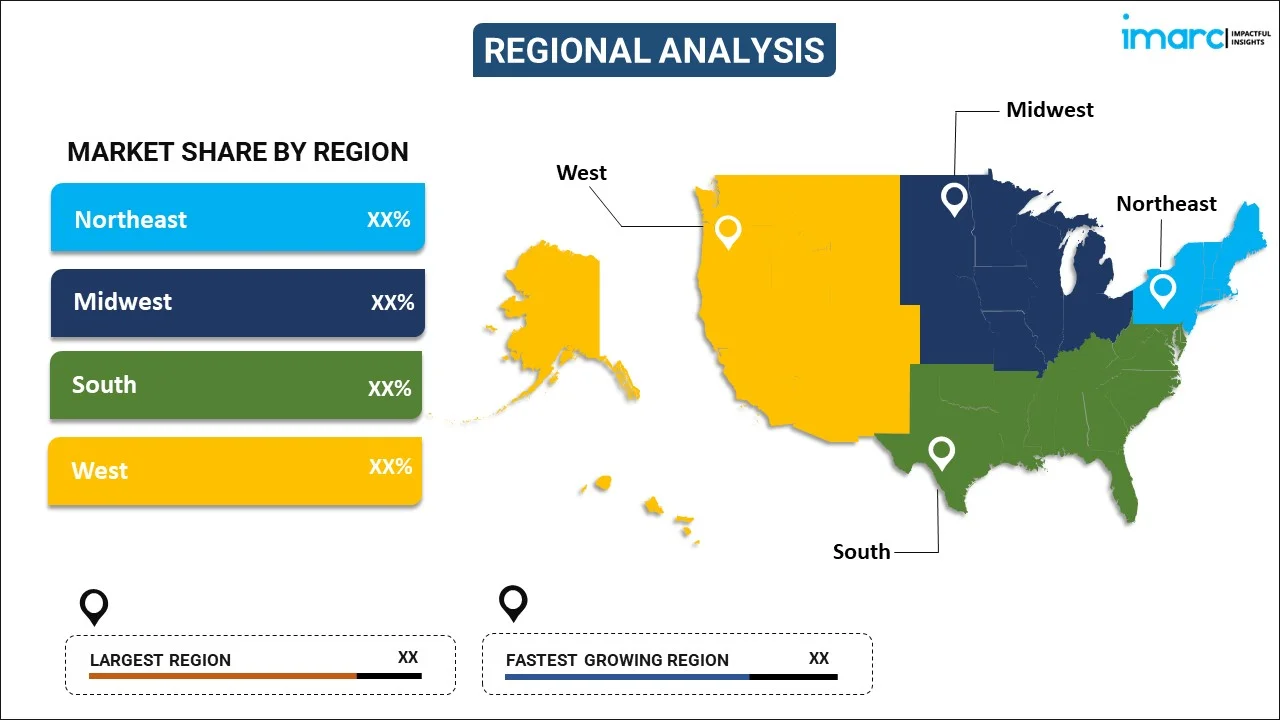
United States Risk Analytics Market Report by Component (Solution, Services), Deployment Mode (On-premises, Cloud-based), Organization Size (Large Enterprises, Small and Medium Enterprises), Application (Strategic Risks, Financial Risks, Operational Risks, Compliance Risks), Industry Vertical (BFSI, IT and Telecom, Retail, Healthcare, Energy and Utilities, Manufacturing, Government and Defense, and Others), and Region 2024-2032
Market Overview:
United States risk analytics market size reached US$ 9.05 Billion in 2023. Looking forward, IMARC Group expects the market to reach US$ 28.3 Billion by 2032, exhibiting a growth rate (CAGR) of 12.60% during 2024-2032. The rising focus among organizations to navigate uncertainties and make informed decisions in an increasingly complex risk landscape is primarily driving the market growth across the country.
|
Report Attribute
|
Key Statistics
|
|---|---|
|
Base Year
|
2023 |
|
Forecast Years
|
2024-2032 |
|
Historical Years
|
2018-2023
|
| Market Size in 2023 | US$ 9.05 Billion |
| Market Forecast in 2032 | US$ 28.3 Billion |
| Market Growth Rate (2024-2032) | 12.60% |
Risk analytics involves a systematic evaluation and quantification of potential uncertainties that businesses may encounter. Utilizing statistical, mathematical, and computational principles, it assess data to identify uncertainties across diverse business processes. By examining various risk categories, such as financial, operational, reputational, and strategic, this analytical approach empowers organizations to make well-informed decisions with a calculated mindset. The primary goal is to understand and alleviate potential negative impacts while concurrently identifying opportunities for growth and enhancement. Equipped with a wide array of techniques and tools, including models, algorithms, simulations, etc., it can analyze extensive datasets to pinpoint potential risk factors. The comprehensive process entails identifying, measuring, and analyzing risks, followed by prioritizing and strategizing appropriate responses to ensure proactive risk management in the business landscape.
United States Risk Analytics Market Trends:
In the United States, the risk analytics market is experiencing a surge, driven by pivotal drivers and shaped by prominent trends. A significant factor is the escalating complexity of business landscapes, urging organizations to adopt advanced risk analytics solutions to navigate uncertainties effectively. Additionally, the escalating demand for real-time insights is another driving force, with businesses seeking timely information to make proactive decisions in an ever-evolving risk environment. Besides this, technological advancements, including artificial intelligence and machine learning, are reshaping the risk analytics landscape in the United States. These innovations enhance predictive modeling and risk identification, empowering organizations to stay ahead of potential threats. Moreover, cloud-based solutions are gaining traction across the country, offering scalability and flexibility in managing vast datasets critical for comprehensive risk assessment. Apart from this, the increasing integration of Environmental, Social, Governance (ESG) factors with risk analytics solutions is also positively influencing the market growth. Furthermore, businesses are recognizing the importance of assessing risks related to sustainability, social responsibility, and corporate governance, aligning risk management with broader organizational values. Besides this, the growing focus on addressing the challenges of a dynamic business environment is expected to propel the market growth across the United States over the forecasted period.
United States Risk Analytics Market Segmentation:
IMARC Group provides an analysis of the key trends in each segment of the market, along with forecasts at the country level for 2024-2032. Our report has categorized the market based on component, deployment mode, organization size, application, and industry vertical.
Component Insights:

- Solution
- Services
The report has provided a detailed breakup and analysis of the market based on the component. This includes solution and services.
Deployment Mode Insights:
- On-premises
- Cloud-based
A detailed breakup and analysis of the market based on the deployment mode have also been provided in the report. This includes on-premises and cloud-based.
Organization Size Insights:
- Large Enterprises
- Small and Medium Enterprises
The report has provided a detailed breakup and analysis of the market based on the organization size. This includes large enterprises and small and medium enterprises.
Application Insights:
- Strategic Risks
- Financial Risks
- Operational Risks
- Compliance Risks
A detailed breakup and analysis of the market based on the application have also been provided in the report. This includes strategic risks, financial risks, operational risks, and compliance risks.
Industry Vertical Insights:
- BFSI
- IT and Telecom
- Retail
- Healthcare
- Energy and Utilities
- Manufacturing
- Government and Defense
- Others
The report has provided a detailed breakup and analysis of the market based on the industry vertical. This includes BFSI, IT and telecom, retail, healthcare, energy and utilities, manufacturing, government and defense, and others.
Regional Insights:

- Northeast
- Midwest
- South
- West
The report has also provided a comprehensive analysis of all the major regional markets, which include Northeast, Midwest, South, and West.
Competitive Landscape:
The market research report has also provided a comprehensive analysis of the competitive landscape. Competitive analysis such as market structure, key player positioning, top winning strategies, competitive dashboard, and company evaluation quadrant has been covered in the report. Also, detailed profiles of all major companies have been provided.
United States Risk Analytics Market Report Coverage:
| Report Features | Details |
|---|---|
| Base Year of the Analysis | 2023 |
| Historical Period | 2018-2023 |
| Forecast Period | 2024-2032 |
| Units | US$ Billion |
| Scope of the Report | Exploration of Historical and Forecast Trends, Industry Catalysts and Challenges, Segment-Wise Historical and Predictive Market Assessment:
|
| Components Covered | Solution, Services |
| Deployment Modes Covered | On-premises, Cloud-based |
| Organization Sizes Covered | Large Enterprises, Small and Medium Enterprises |
| Applications Covered | Strategic Risks, Financial Risks, Operational Risks, Compliance Risks |
| Industry Verticals Covered | BFSI, IT and Telecom, Retail, Healthcare, Energy and Utilities, Manufacturing, Government and Defense, Others |
| Regions Covered | Northeast, Midwest, South, West |
| Customization Scope | 10% Free Customization |
| Report Price and Purchase Option | Single User License: US$ 3699 Five User License: US$ 4699 Corporate License: US$ 5699 |
| Post-Sale Analyst Support | 10-12 Weeks |
| Delivery Format | PDF and Excel through Email (We can also provide the editable version of the report in PPT/Word format on special request) |
Key Questions Answered in This Report:
- How has the United States risk analytics market performed so far and how will it perform in the coming years?
- What has been the impact of COVID-19 on the United States risk analytics market?
- What is the breakup of the United States risk analytics market on the basis of component?
- What is the breakup of the United States risk analytics market on the basis of deployment mode?
- What is the breakup of the United States risk analytics market on the basis of organization size?
- What is the breakup of the United States risk analytics market on the basis of application?
- What is the breakup of the United States risk analytics market on the basis of industry vertical?
- What are the various stages in the value chain of the United States risk analytics market?
- What are the key driving factors and challenges in the United States risk analytics?
- What is the structure of the United States risk analytics market and who are the key players?
- What is the degree of competition in the United States risk analytics market?
Key Benefits for Stakeholders:
- IMARC’s industry report offers a comprehensive quantitative analysis of various market segments, historical and current market trends, market forecasts, and dynamics of the United States risk analytics market from 2018-2032.
- The research report provides the latest information on the market drivers, challenges, and opportunities in the United States risk analytics market.
- Porter's five forces analysis assist stakeholders in assessing the impact of new entrants, competitive rivalry, supplier power, buyer power, and the threat of substitution. It helps stakeholders to analyze the level of competition within the United States risk analytics industry and its attractiveness.
- Competitive landscape allows stakeholders to understand their competitive environment and provides an insight into the current positions of key players in the market.
Need more help?
- Speak to our experienced analysts for insights on the current market scenarios.
- Include additional segments and countries to customize the report as per your requirement.
- Gain an unparalleled competitive advantage in your domain by understanding how to utilize the report and positively impacting your operations and revenue.
- For further assistance, please connect with our analysts.
 Inquire Before Buying
Inquire Before Buying
 Speak to an Analyst
Speak to an Analyst
 Request Brochure
Request Brochure
 Request Customization
Request Customization




.webp)




.webp)












